#Mizzurna Falls
Text



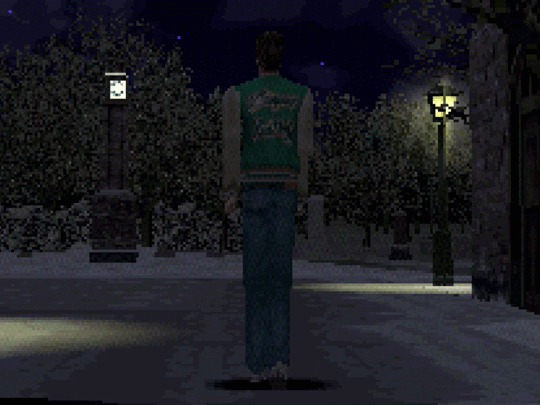
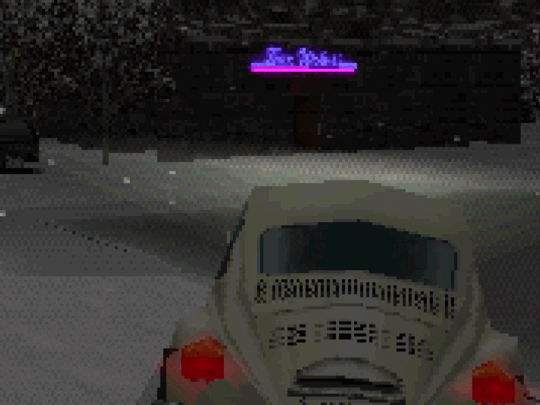
ミザーナフォールズ
Mizzurna Falls
(PS1, 1998)
2K notes
·
View notes
Text

Mizzurna Falls (1998) - Title Menu
30 notes
·
View notes
Photo
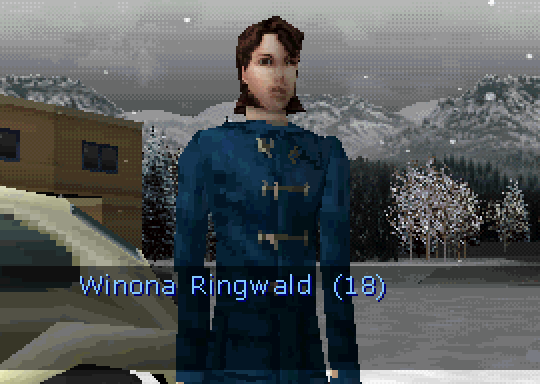
“Winona Ringwald” --
Mizzurna Falls (Human Entertainment - PSX - 1998)
218 notes
·
View notes
Text

26 notes
·
View notes
Text


Have you ever played 90s twin peaks inspired Japan exclusive game Mizzurna Falls and gone “wow I wish someone had a made a tourist themed shirt based on this” then hey I have a gift for you at this link
#this was 100% a spur of the moment design but I’m glad I did it!#mizzurna falls#psx#psx games#ps1#retrocore#retro games#retro aesthetic#retro gaming#retro game
4 notes
·
View notes
Text

Today’s disabled character of the day is Barbara Holden from Mizzurna Falls, who is a wheelchair user with a substance use disorder
Requested by Anon
[Image Description: Pixel drawing of an older woman with short white hair and blue eyes. She is wearing a brown sweater and white undershirt. In the lower left corner of the frame is “Barbara” in yellow text.]
#wheelchair user character#sud character#Mizzurna Falls#Mizzurna Falls Barbara#Barbara Holden#disabled character of the day
3 notes
·
View notes
Text
youtube
Finished my series of videos and packaged it into one single easy to watch video. Enjoy the Corolado Kino that is Mizzurna Falls
#horror games#youtube#underrated horror game#horrifyworld#underrated horror#underrated horror games#mizzurna falls explained#mizzurna falls
3 notes
·
View notes
Text

3 notes
·
View notes
Photo

Further, speech can never exactly represent perceptibles, since it is different from them, and perceptibles are apprehended each by the one kind of organ, speech by another. Hence, since the objects of sight cannot be presented to any other organ but sight, and the different sense-organs cannot give their information to one another, similarly speech cannot give any information about perceptibles. Therefore, if anything exists and is comprehended, it is incommunicable.
Gorgias (483-375 BC)
Gorgias’ claims . . . greatly appealed to the poets, writers, and philosophers of the 20th century who were trying to construct some working philosophy following the horrors of World War I and then World War II . . . The philosophical and religious models that were accepted prior to the World Wars were challenged by the unprecedented destruction, death, and abundant evidence of collective and individual atrocities committed. In the aftermath of both wars, the suggestion that each individual inhabited their own world, incommunicable to others (thereby rendering the concept of a shared reality or universal values impossible) began to make sense to many thinkers, informing aspects of Existentialism, and continuing to exert significant influence upon philosophers of various schools of thought in the present.
worldhistory.org
3 notes
·
View notes
Text
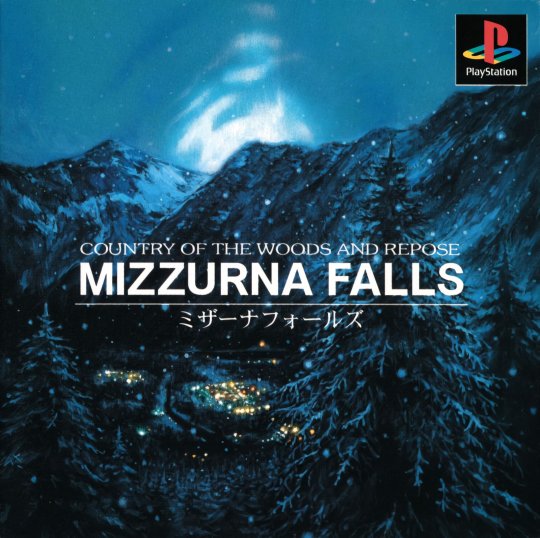
Mizzurna Falls (Human Entertainment, 1998)
1 note
·
View note
Note
📮🔥🔥🔥
Ok I know I've ranted to u about this before but as an offshoot of it
Of many of games inspired by Twin Peaks I think Harvester is probably one of the better ones. While it's tone is completely inverse of TP (a cynical tone with cast of off putting characters as opposed to the hopeful tone with unique but still understandable characters) I think the inverse of that is done really well
#ant emails#sh doest really have those vibes i suppose mizzurna falls bc its so directly one to one to some degree(pos) does but harvester does it well
3 notes
·
View notes
Text
The Retro Horror Games Iceberg Chart, Ver. 2.0

Please read my notes below for more context. I always take asks about retro horror games, as well. I have at least some experience with most of these.
This chart can be used in personal projects or YouTube videos, but please ask me first and do not remove my credits. Thank you.
This is a massive, updated version of an iceberg chart I made.
It's intended as a guide for a mostly Western audience (and preservationists) to discover more of these games, not as a 100% accurate ranking.
So don't worry about my placements too much, just check out the games that sound interesting to you.
NOTES:
-Games on lower tiers like Aoi Shiro or Mizzurna Falls have notable fanbases, but were placed there because, since they did not get official ports outside of their home country, they will not be as well-known or can be harder to find physical copies of.
-PC and console games only. Focus is on the 90s and 2000s because that's more my area of expertise.
-I've included a couple of non-horror games like Chulip, Conker's Bad Fur Day and Majora's Mask due to their horror aesthetics or close ties to the genre. As a collector, I always feel it's better to include more rather than less, and these games seem at home here.
#horror games#survival horror#japanese horror#silent hill#dreamcast#clock tower#obscure games#japan only games#retro games#resident evil biohazard#playstation#ps1 ps2#rule of rose#dark fantasy#game collecting
1K notes
·
View notes
Text
I've been waiting for this Verge article to come out for several months after Marc Laidlaw told me he was being interviewed for it, and now it's finally here, an essay about David Lynch's influence on various video games, both mainstream and indie, and his failed attempt to make his own game, Woodcutters from Fiery Ships:
Besides Marc Laidlaw, other interviewees include a little bit from Haruhiko Shono (GADGET), Sam Lake (Alan Wake), Taichi Ishizuka (Mizzurna Falls), and a few others.
#david lynch#alan wake#gadget past as future#i was working on a gadget essay that i put on hold months ago to wait for this and see if there would be new info#i might get back to it or not depending on how i feel#half life
9 notes
·
View notes
Text

Mizzurna Falls (ミザーナフォールズ) (PSX) 1998
#90s#videogames#video games#vintage#retrogaming#art#sony playstation#sony#playstation#psx#ps1 aesthetic#psone#lowpoly#1990s#liminal#weirdcore#oddcore#japan#dreamcore#unreality#90s nostalgia#90s aesthetic#graphic design#blue moodboard#winter#winter aesthetic#snow#blue
9 notes
·
View notes
Text
J A P A N o F I L E S # 8 -- Chronicle of Starting a Shina Soba Shop

[ The last JAPANoFILES feature was written eleven years ago. The post reached an audience of many thousands and helped create awareness about a powerful videogame creation left buried beneath the snow: Mizzurna Falls. One of its readers went on to translate the game to English, in fact. This is an impossible act to follow. In reviewing the original intention of these articles, it occurred to me that if I’m to give continuity to this effort, I should carry on seeking items of both cultural and videoludic relevance that have slipped between the cracks of history. Today’s story was one I began writing shortly before this tumbleblog hibernated and that, to my knowledge, has not yet been satisfactorily told until now by any of my fellow japanophiles. As you read it, I hope to instil in you the same gemütlichkeit you’d get from a steaming bowl of noodles on a cold winter evening.]

From the very onset, チャルメラ suggests a fascinating divide: although the title and cover art will hardly resonate with western observers, virtually anyone in Japan will instantly recognize what it is all about. To them, this is as household a name as they come, and one synonymous with precooked noodle deliciousness and convenience for over half a century.
Charumera is a much beloved line of instant noodle products introduced by Myojo Foods, a company whose foundations date back to the mid-twentieth century. Its name is interchangeable for cup noodles in many areas of Japan and the Japanese diaspora, including Brazil. The company grew a reputation for introducing some of the early revolutions in this food category that we now take for granted. In 1961, it was the first to propose the concept of cup noodles, a simplified meal preparation method made possible by ice cream type paper containers capable of withstanding the pouring of boiling water. Many misattribute this invention to Nissin due to the fact that Myojo, who lacked the wherewithal to file for a utility patent, could only profit out of their idea by selling production and commercialization rights to that prosperous food giant. The Tokyo-based company was also the first to usher in the now ubiquitous separate powder flavouring bags, initially under the name Myojo Ramen in 1962, and later rebranded as Myojo Charumera in 1966, with an improved formula that made this a reference to a fast-food seeking population.
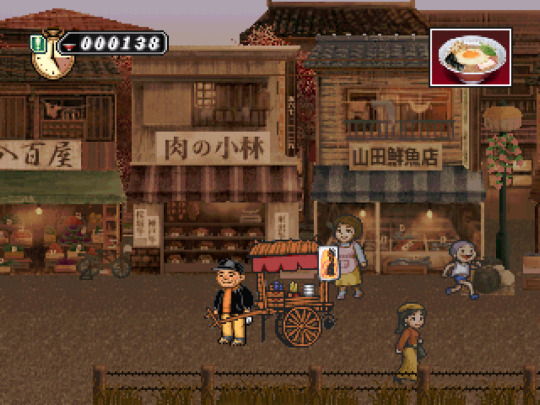
The man in the above cover art for this Playstation game adaptation, also titled Charumera, consists of the product's very own mascot, whom the Japanese lovingly call Ojisan (uncle). Few could have predicted that he would ever star in a videogame of his own. Created by Bits Laboratory and published by Victor Interactive Software on November 1999, it is unclear whether the game was sponsored or merely certified by Myojo. In the absence of more concrete information, all appears to indicate that this project was developed with the clear intent to pay homage to the brand and iconic character, only tangentially serving the purpose of advertising.
~ An ageless man carries the weight of tradition ~
In Charumera, the good uncle merrily pushes his Yatai about the streets of a fictitious town at the height of the Shōwa era. Momentarily, if the player relinquishes the control pad, he may feel at ease to wipe the sweat off his face with his chef's side towel. The streets are wide and long and barely any automobiles can be spotted. He does not speak during any of the ample verbal exchanges, although a narrator of unknown origin may on occasion report on his sentiments and reactions. He is simultaneously the central component of the game and a mere spectator to unfolding events.

A map of the aptly-named Naruto town, itself a microcosmic representation of Japan in the fifties and its dichotomy between urban and rural zones.
One part of the game has the player engage in the basic management of a mobile food stand business, starting with an understanding of the different areas of Naruto, its distant farm fields, a fishing wharf, sooty industrial zone and the bustling city centre. Each turn represents a business day, lasting from late afternoon to the wee hours of the night. Different locations at different times of the day represent varying degrees of foot traffic.
When the turn is complete, the player is free to indulge in culinary research and development, customizing all aspects of a ramen dish: the different varieties of noodles, type of bowl, seasonings, stock base and toppings. At first, the selection is limited to a set of base ingredients that can be expanded by the discovery of new areas and characters, some of them tradesmen and produce suppliers. The best selection of components ensures the most customers and, consequently, the most servings. Currency does not exist in the game. Its functional end is reached when enough meals been served for the empty bowl stack to rise above the height of the fabled mount Fuji. No small feat for a self-employed man of advancing years.
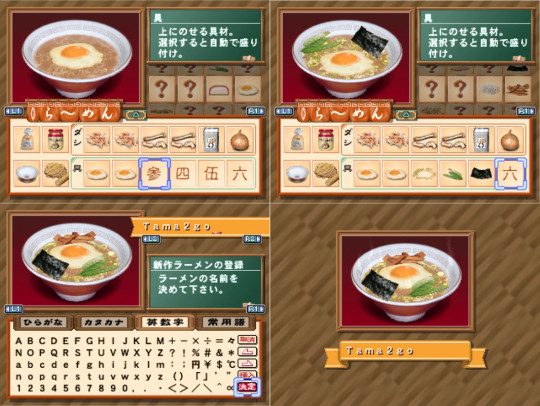
The interface for assembling Ramen bowls puts one in mind of Cybernetic’s less-than-stellar Pizza Tycoon, enabled by the overlapping of transparent bitmaps. The final presentation adds a plume of smoke to what may well turn out to be a mouth-watering success.
Charming as the business simulation aspect of the game system may be, at its heart, Charumera is an adventure centred around the exploration of a city and its denizens; one where the main goal is to bring people together through a common appreciation of the quintessential Japanese delicacy that is ramen. Scattered across the different areas, and at different times of the day, exist a number of key characters who, unlike the average passerby, will not only stop for nutritious soup but also prompt a conversation. This is done, primarily, in order for players to receive an assessment of their dishes. Some of these self-professed critics will be quite forthcoming in their comments, suggesting the flavor profile or combination of fixings most likely to please them. Others add difficulty to the game by keeping their contributions brief and enigmatic. By learning of their preferences, the player is invited to adjust the composition of the dishes and return to the same location, at the same hour of the day, to attempt another serving and achieve complete satisfaction.
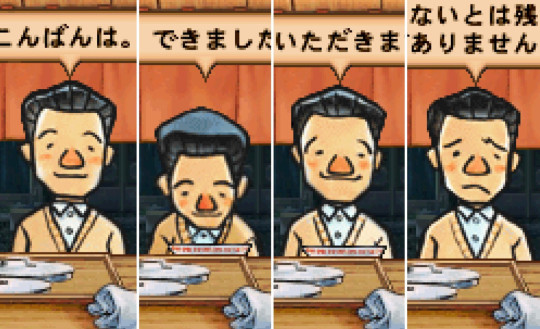
Customers tasting Ojisan’s cookery will react with different facial expressions. Some, on the other hand, will slurp his stock while remaining silent and expressionless. To captivate the more demanding customers, subtler signals need to be observed.
At times, a fully content customer's quest will be completed with a round of smiles, praise and gratitude. But on occasion, these may set in motion a more layered story to be unfolded over the remaining course of the game. An illustrative example of this is the recluse monk who is undergoing a long prayer exercise, and of whose rigorously vegeterian dietary needs can only be learned through the input from other characters who relate the motive of his abstinence. The developers also integrated a clever mechanism to aid in the understanding of what constitutes a fine plate of noodles by allowing the player to regularly visit the home of one of uncle’s best friends, a taxi driver who will be delighted to perform a tasting and attribute a score.

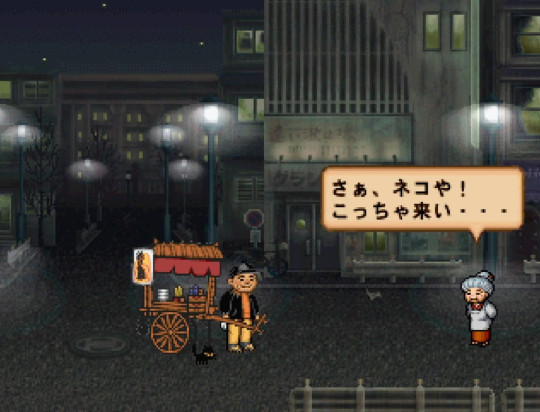
The evolution of Ojisan’s design over the years observed some changes including a much needed footgear upgrade from hardwood zori to a snug pair of sneakers (left). The alternative, far less inspired cover art for the game's second edition (right). The black cat Suzuneko only makes its first appearance a couple of hours into the game as a part of a substory (bottom).
~ Sweet shawm music ~
The long tradition of Yatai-wheeling cooks is only supplanted in age by ramen itself. Decades before it came to known by its present name, noodle soup was commonly referred to in Japan as Shina Soba, a clear enough reference to its nonetheless opaque Chinese ancestry. Japan’s fast-paced industrial development in the late 19th century caused severe economic and demographic changes. A host of policies adopted by the government expedited the rift between an increasingly impoverished and isolated countryside population, for whom labour-intensive agriculture was no longer a profitable activity in view of neighbouring competition. This resulted in an exodus to the cities, in droves, and the search for the opportunity of low-level employment in manufacturing. The extended work hours and taxing duties of factories paved the way for a new type of meal, one substantial enough to sustain workers and at the same time affordable for regular consumption.
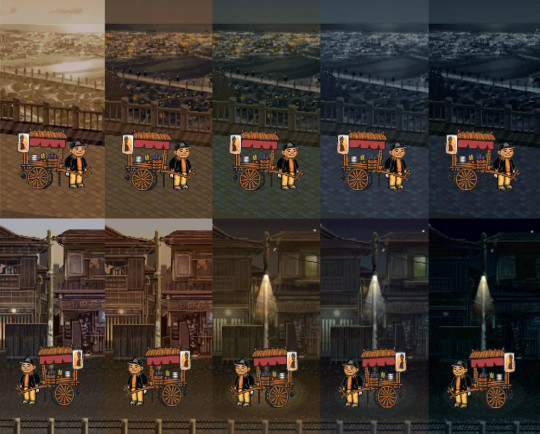
The passing of time is strikingly reflected in the backgrounds, the result of a clever combination of gradual colour scheme alterations and the loading of new bitmaps. The switch of music themes equally signals the change.
Wheat flour imports from Korea and Taiwan being more affordable than Japanese rice, this new noodle soup found its way among the most predominant food offerings of the early 20th century; first introduced by Chinese emigrant-owned eateries and later integrated into even the most traditional Japanese restaurants in view of its high demand. Yatai, already used for many decades in Japan to bring prepared food to residences, were one of the prime vehicles behind the propagation of Shina Soba by keeping this delicacy in permanently close reach.

As illustrated by the emblematic Charumera product logo, the sounding of the horn is an instrumental ritual of food cart owners, enabling their presence to be known. Conversely, this is a recurring action performed in the game with the pressing of the O button. Once the sound plays, bystanders will gather around the ever-cheerful uncle.
The name ‘charumera’ refers to a double-reed woodwind instrument that is said to have derived from ‘charamela’ – Portuguese for shawm -, hinting at a possible introduction to the Japanese by way of Christian missionaries from that provenance sometime during the 16th century. The simplicity of the instrument made it popular among pushcart owners, not only because its sound signalled their impending arrival, but also due to the clever employment of signature melodies in what can only be described as a primordial manifestation of brand awareness. All these practices are exquisitely demonstrated in a scene from Yasujirō Ozu’s 1936 film Hitori Musuko (The Only Son). Needless to say, a viewing of the entire picture is most advised.
~ Ramen as the expression of longing for a bygone era ~
In the present, where connections to history have been severed, ramen is a tool to rearticulate the charm of Japan’s traditions. - Hayamizu Kenrō
There couldn’t have been a more appropriate moment to reintroduce Charumera. Ramen is more of a nipponic cuisine staple than it has ever been before, sustaining its high demand across the islands, each region unyieldingly asserting the superiority of their own rendition. As for the rest of the world, ramen has long expanded beyond the constricted cubbyholes in which it remained for decades, when only urbane gourmets or ablutophobic otakus dared to publicly utter the word above a whisper.
Japan is presently witnessing an intriguing wave of nostalgia for the Showa era, as evidenced by the multitude of visitors to the recently inaugurated Yūhi No Oka Shōtengai (Sunset Hill Shopping Street) at Seibuen Yenchi, a massive theme part located in the Saitama prefecture of Tokyo. The concept behind this attraction is to recreate the life of a small shopping district from the 1960s, faithfully capturing the architecture, décor, fashion, transportation, advertising, stores and products from this period. Visitors seem delighted at the prospect of evasion to what they perceive as an easier, more compassionate style of living. (recommended viewing: NHK feature "Showa Nostalgia", May 2022).

A similar ideal is humbly pursued with this unique software: the use of modern technologies as a medium to connect to younger game-playing audiences, reciting a tale from a time when simple pleasures such as a cup of hot soup were deemed an enriching experience, for those preparing and feasting on it alike. Its only message is the celebration of amity and unity, as conveyed by its ultimate purpose: to weave lasting bonds with the community, establish the business as a local institution by acts of kindness and cooperation, inspire followers through hard work ethics and gain full support of every element of society. Its period recreation prowess may lack the verve of SEGA’s seminal Shenmue, published that same year. The exploits of its game system surely pale in comparison with the gargantuan catalogue of expansive role-playing games for which this epoch came to be celebrated. This is, after all, the product of nearly self-sufficient designers making as good a use of their previously acquired skills and experience as was permitted by the modesty of the budget in reach. In true indie form, it nevertheless excels at what the majority of the towering productions of the day failed to possess – a soul.
~ Heisei 11: the year of digital noodles ~
Though infrequent at the turn of the century, food and cooking themed video games have witnessed a vast expansion in popularity, presently existing in numbers sufficient to constitute a subgenre all their own. The ordinariness of most proposals in this category of late, however, beg for a tribute to earlier accomplishments. In general, food has been a pervasive theme in Japanese games since the early 1980s – after all, what is Pac-Man’s main premise if not to devour? For the purposes of this article, a more refined search is required to single out those pertinent creations still shrouded in relative obscurity.
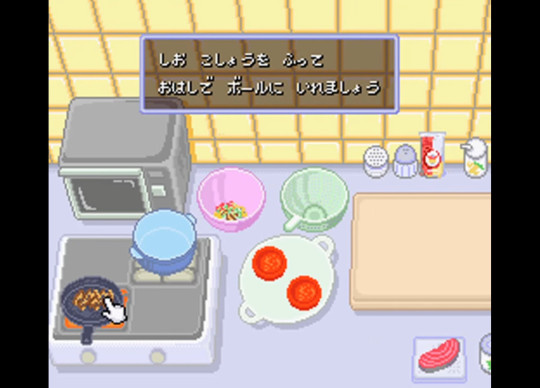
Ajinomoto's foray into the world of video game product placement may have been the unintentional inspiration for a brave new console game category.
Certainly, one of the first Japanese games on the subject of cooking was Motoko-chan no Wonder Kitchen, a 1993 promotional Super Famicom cartridge obtainable only in return for mailing Ajinomoto mayonnaise cut-out label seals, all part of a contest for which ten thousand units were produced. The relevance of this game cannot be overstated: not only does it produce an early example of a stunningly functional dish assembly minigame, it also represents the early days of that obscure Japanese tradition wherein the video game space is permeated by advertising from large-scale food corporations.
A year later, the doyen of bishōjo games, KID, teamed up with Nissin Foods to give digital life to UFO Kamen Yakisoban, the superhero from their saucer-shaped yakisoba cup noodle ad, this time for an eccentric Super Famicom beat ‘em up in which the kitchen remains off-limits. In early 1999, KID would in turn partner with PepsiCo for the production of Pepsiman on the Playstation, Japan’s most recognizable face for the world-renowned soft drink, a game that garnered cult following among western players in the early 2000s.
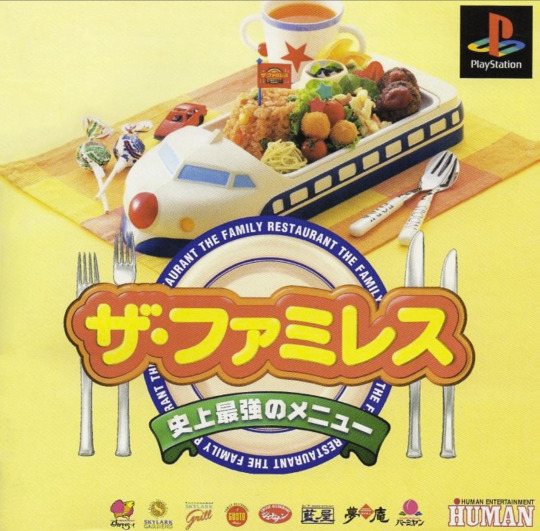
It never ceases to amaze how many ports of The Family Restaurant hit the market between 1998 and 2000 alone. Just a year after the original Masterpiece game, a slightly improved version developed by ArtDink also made its way to the PC. There were also three editions of the game for the Playstation, each a unique variation of the base design. Notably, the Human edition included a partnership deal with the Skylark group, advertising a handful of their most beloved restaurant chains. The above cover art boasts the logos for Yumean, Aiya, Jonathan, Gusto and the temple of Chinese food deliciousness, Bamiyan.
Other honourable mentions from the latter half of the decade include Burger Burger, a Maxis/Bullfrog styled fast-food chain restaurant strategy simulator designed by board game designer and 1988 Monopoly word-champion Hyakuta Ikuo; the 1998 Masterpiece personal computer game Za Famiresu (The Family Restaurant), another restaurant business sim ported to the Playstation in 1999 by Human Entertainment, in an edition rececing the sponsorship from the major restaurant group Skylark; and Cooking Fighter Hao, a remarkably unusual Nippon-Ichi combat game in which the player slashes live animals for meals to be prepared.

Ore No Ryouru demands impeccable chopping skills at the cost of a few fingers (left). A leering look at historical Japanese society, Ramen Bashi is best described as a game of customs (right).
The year of 1999 represented a peak of creativity within the genre. Invariably, the first piece of evidence sustaining this claim is Ore No Ryouri, the result of a partnership between Sony and Argent intended to support marketing efforts for the original Dual Shock controller. Much like Saru Getchu, the game makes sensible use of the dual sticks in replicating the taxing kinesis that restaurant-grade food preparation entails. The game was a small success in Japan due to its hilarity and frantic pace, meriting a Playstation the Best edition and PS3/Vita rerelease.
Making its appearance mere weeks before Charumera, Ramen Bashi, developed by Media Entertainment, is another triumph from that same year, one that remains largely unappreciated even among Japanese players. Unlike the aforementioned oddities, novelties and brazen publicity stunts, this is a game of some depth and complexity. In it, the player assumes the role of a soldier demobilized from Siberia after the war who takes over his father’s ramen shop, finding himself encircled by a society of commoners, thugs and other such unpleasant people that, throughout the four decades during which the game takes place, ceaselessly prey on his Hakaiou-like, short-tempered nature. For every ounce of heart that Charumera possesses, Ramen Bashi matches it with its peculiar brand of satire and sardonic humour. So caustic, in fact, that the studio was forced to tone it down in for their ensuing gourmet series, referred to by some as the holy trinity of PlayStation cooking games - Yakiniku Bugyo, Nabe Kazoku, and Yakitori Musume. An article of similar scope to this one has yet to be written about any of them.
More JAPANoFILES features
JAPANoFILES #7 - Country of Bears and Burgers
JAPANoFILES #6 - Violent Cop
#playstation#sony#ramen#myojo#nissin#charumera#instant ramen#videogame#obscure games#obscure game#Japanese food
31 notes
·
View notes
Text
Accepted Character 6/1/2023
Junbeom's grandfather from Shingi: The Spirit's Playbook
Eda Clawthorne from The Owl House
Ezequiel from Angel's Quest
Miu Shinoda from Nana
K from Scribbling the Cat
Biggafoot from Banjo-Kazooie
Jinsei Kimura from Cape of Spirits
Dot Barrett from Mashle: Magic and Muscles
Alan Reynolds from Hypnospace Outlaw
Captain Harry Fredriksen from Brødrene Dal
Sevda from Woven
Barbara Holden from Mizzurna Falls
Juwon Kang from The Most Ordinary Girl
Roddy Wall from Hypnospace Outlaw
Tiffany Wright from Hypnospace Outlaw
Yin from Bug Fables
Aristotle from Billie Bust Up
Barnaby from Billie Bust Up
Jam from Pet
Suryong Baek from Best Teacher Baek
Alfie from Alfie the Werewolf
Erick Helman (Chowder Man) from Hypnospace Outlaw
Sarina Tendouji from Oshi no Ko
Katrina King from Girl Gone Viral
Aileen from Bravely Default
Yukito Orikasa from Idolish7
Ms Everton from Do You Remember
Tunji from Ukpang
Ben Guthrie from Vera
Rena Miyauchi from Blue Reflection: Second Light
Stuffy from Doc McStuffins
Grumpybones from Arthur
Alfonso from the Legend of Zelda series
Patrick Bradley from Midsomer Murders
Kakeru Naruse from Orange
Wheelchair Racer from the LEGO series
Frostpaw from the Warriors series
Boris from 64 Zoo Lane
Jihun Seo from Rewriting the Villainess
Snowbird from the Warriors series
Barley from the Warriors series
unnamed old man from Immortal Weakling
Earnest from Shining Force
Petalfall from the Warriors series
Stonepelt from The Warriors series
Navil from House Keeper
Aquamarine Hoshino (Aqua) from Oshi no Ko
336 Requests Remain
11 notes
·
View notes